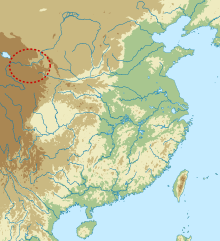 | |||||||
| Geographical range | upper Yellow River | ||||||
|---|---|---|---|---|---|---|---|
| Period | Neolithic China | ||||||
| Dates | c. 3300 – c. 2000 BC | ||||||
| Preceded by | Yangshao culture (5000-3000 BCE) | ||||||
| Followed by | Qijia culture | ||||||
| Chinese name | |||||||
| Simplified Chinese | 马家窑文化 | ||||||
| Traditional Chinese | 馬家窯文化 | ||||||
| |||||||
The Majiayao culture was a group of neolithic communities who lived primarily in the upper Yellow River region in eastern Gansu, eastern Qinghai and northern Sichuan, China.[1] The culture existed from 3300 to 2000 BC. The Majiayao culture represents the first time that the upper Yellow River region was widely occupied by agricultural communities and it is famous for its painted pottery, which is regarded as a peak of pottery manufacturing at that time.
The Majiayao culture benefited from the warm and humid climatic conditions from the Late Glacial to the Middle Holocene, which led to flourishing agricultural production and rapid population growth. These conditions changed with the aridification of the Late Holocene, provoking material and cultural decline.[2]
The Majiayao culture may be associated with the expansion of early Sino-Tibetan peoples during the Neolithic.[3]
- ^ Liu & Chen (2012), p. 232.
- ^ Li, Yu; Zhang, Zhansen; Zhou, Xueru; Gao, Mingjun; Li, Haiye; Xue, Yaxin; Duan, Junjie (1 May 2023). "Paleo-environmental changes and human activities in Shiyang River Basin since the Late Glacial". Chinese Science Bulletin: 3884. doi:10.1360/TB-2022-0965.
The long period of warm and humid climatic conditions from the Late Glacial to the Middle Holocene favoured the development and expansion of the Majiayao and Qijia cultures. This stable and agriculturally suitable climate was conducive to increased food production, which contributed to rapid population growth. However, the continuous aridification that began in the Late Holocene led to a decline in agricultural production and insufficient food and water supply, which hampered population growth and cultural development.
- ^ Liu, Li; Chen, Jian; Wang, Jiajing; Zhao, Yanan; Chen, Xingcan (2022-12-20). "Archaeological evidence for initial migration of Neolithic Proto Sino-Tibetan speakers from Yellow River valley to Tibetan Plateau". Proceedings of the National Academy of Sciences. 119 (51): e2212006119. doi:10.1073/pnas.2212006119. ISSN 0027-8424. PMC 9907151. PMID 36508670.
